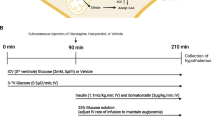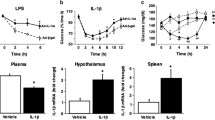Abstract
Brain metabolism is highly dependent on glucose, which is derived from the blood circulation and metabolized by the astrocytes and other neural cells via several pathways. Glucose uptake in the brain does not involve insulin-dependent glucose transporters; however, this hormone affects the glucose influx to the brain. Changes in cerebrospinal fluid levels of S100B (an astrocyte-derived protein) have been associated with alterations in glucose metabolism; however, there is no evidence whether insulin modulates glucose metabolism and S100B secretion. Herein, we investigated the effect of S100B on glucose metabolism, measuring D-3H-glucose incorporation in two preparations, C6 glioma cells and acute hippocampal slices, and we also investigated the effect of insulin on S100B secretion. Our results showed that: (a) S100B at physiological levels decreases glucose uptake, through the multiligand receptor RAGE and mitogen-activated protein kinase/ERK signaling, and (b) insulin stimulated S100B secretion via PI3K signaling. Our findings indicate the existence of insulin-S100B modulation of glucose utilization in the brain tissue, and may improve our understanding of glucose metabolism in several conditions such as ketosis, streptozotocin-induced dementia and pharmacological exposure to antipsychotics, situations that lead to changes in insulin signaling and extracellular levels of S100B.







Similar content being viewed by others
References
Belanger M, Magistretti PJ (2009) The role of astroglia in neuroprotection. Dialogues Clin Neurosci 11:281–295
Pellerin L, Magistretti PJ (2004) Neuroenergetics: calling upon astrocytes to satisfy hungry neurons. Neurosci Rev J Bring Neurobiol Neurol Psychiatry 10:53–62. doi:10.1177/1073858403260159
Pellerin L (2008) Brain energetics (thought needs food). Curr Opin Clin Nutr Metab Care 11:701–705. doi:10.1097/MCO.0b013e328312c368
Banks WA, Owen JB, Erickson MA (2012) Insulin in the brain: there and back again. Pharmacol Ther 136:82–93. doi:10.1016/j.pharmthera.2012.07.006
Gerozissis K (2004) Brain insulin and feeding: a bi-directional communication. Eur J Pharmacol 490:59–70. doi:10.1016/j.ejphar.2004.02.044
Unger JW, Moss AM, Livingston JN (1991) Immunohistochemical localization of insulin receptors and phosphotyrosine in the brainstem of the adult rat. Neuroscience 42:853–861
Duarte AI, Moreira PI, Oliveira CR (2012) Insulin in central nervous system: more than just a peripheral hormone. J Aging Res 2012:384017. doi:10.1155/2012/384017
Chen Z, Zhong C (2013) Decoding Alzheimer’s disease from perturbed cerebral glucose metabolism: implications for diagnostic and therapeutic strategies. Prog Neurobiol 108:21–43. doi:10.1016/j.pneurobio.2013.06.004
De la Monte SM (2012) Brain insulin resistance and deficiency as therapeutic targets in Alzheimer’s disease. Curr Alzheimer Res 9:35–66
Steiner J, Bernstein H-G, Bogerts B et al (2008) S100B is expressed in, and released from, OLN-93 oligodendrocytes: influence of serum and glucose deprivation. Neuroscience 154:496–503. doi:10.1016/j.neuroscience.2008.03.060
Donato R (2003) Intracellular and extracellular roles of S100 proteins. Microsc Res Tech 60:540–551. doi:10.1002/jemt.10296
Donato R, Sorci G, Riuzzi F et al (2009) S100B’s double life: intracellular regulator and extracellular signal. Biochim Biophys Acta 1793:1008–1022. doi:10.1016/j.bbamcr.2008.11.009
Donato R, Cannon BR, Sorci G et al (2013) Functions of S100 proteins. Curr Mol Med 13:24–57
Frizzo JK, Tramontina F, Bortoli E et al (2004) S100B-mediated inhibition of the phosphorylation of GFAP is prevented by TRTK-12. Neurochem Res 29:735–740
Landar A, Caddell G, Chessher J, Zimmer DB (1996) Identification of an S100A1/S100B target protein: phosphoglucomutase. Cell Calcium 20:279–285
Zimmer DB, Van Eldik LJ (1986) Identification of a molecular target for the calcium-modulated protein S100. Fructose-1,6-bisphosphate aldolase. J Biol Chem 261:11424–11428
Gonçalves C-A, Leite MC, Nardin P (2008) Biological and methodological features of the measurement of S100B, a putative marker of brain injury. Clin Biochem 41:755–763. doi:10.1016/j.clinbiochem.2008.04.003
Kleindienst A, Hesse F, Bullock MR, Buchfelder M (2007) The neurotrophic protein S100B: value as a marker of brain damage and possible therapeutic implications. Prog Brain Res 161:317–325. doi:10.1016/S0079-6123(06)61022-4
Rojas A, Delgado-López F, González I et al (2013) The receptor for advanced glycation end-products: a complex signaling scenario for a promiscuous receptor. Cell Signal 25:609–614. doi:10.1016/j.cellsig.2012.11.022
Biasibetti R, Tramontina AC, Costa AP et al (2013) Green tea (−)epigallocatechin-3-gallate reverses oxidative stress and reduces acetylcholinesterase activity in a streptozotocin-induced model of dementia. Behav Brain Res 236:186–193. doi:10.1016/j.bbr.2012.08.039
Vizuete AF, de Souza DF, Guerra MC et al (2013) Brain changes in BDNF and S100B induced by ketogenic diets in Wistar rats. Life Sci 92:923–928. doi:10.1016/j.lfs.2013.03.004
Gonçalves CA, Leite MC, Guerra MC (2010) Adipocytes as an important source of serum S100B and possible roles of this protein in adipose tissue. Cardiovasc Psychiatry Neurol 2010:790431. doi:10.1155/2010/790431
Suzuki F, Kato K (1985) Inhibition of adipose S-100 protein release by insulin. Biochim Biophys Acta 845:311–316
Steiner J, Bernstein H-G, Schiltz K et al (2014) Decrease of serum S100B during an oral glucose tolerance test correlates inversely with the insulin response. Psychoneuroendocrinology 39:33–38. doi:10.1016/j.psyneuen.2013.10.001
Bobermin LD, Quincozes-Santos A, Guerra MC et al (2012) Resveratrol prevents ammonia toxicity in astroglial cells. PLoS One 7:e52164. doi:10.1371/journal.pone.0052164
De Souza DF, Leite MC, Quincozes-Santos A et al (2009) S100B secretion is stimulated by IL-1beta in glial cultures and hippocampal slices of rats: likely involvement of MAPK pathway. J Neuroimmunol 206:52–57. doi:10.1016/j.jneuroim.2008.10.012
Tramontina AC, Nardin P, Quincozes-Santos A et al (2012) High-glucose and S100B stimulate glutamate uptake in C6 glioma cells. Neurochem Res 37:1399–1408. doi:10.1007/s11064-012-0722-4
Nardin P, Tortorelli L, Quincozes-Santos A et al (2009) S100B secretion in acute brain slices: modulation by extracellular levels of Ca(2+) and K(+). Neurochem Res 34:1603–1611. doi:10.1007/s11064-009-9949-0
Zanotto C, Abib RT, Batassini C et al (2013) Non-specific inhibitors of aquaporin-4 stimulate S100B secretion in acute hippocampal slices of rats. Brain Res 1491:14–22. doi:10.1016/j.brainres.2012.10.065
Pellerin L, Magistretti PJ (1994) Glutamate uptake into astrocytes stimulates aerobic glycolysis: a mechanism coupling neuronal activity to glucose utilization. Proc Natl Acad Sci U S A 91:10625–10629
Peterson GLA et al (1977) A simplification of the protein assay method of Lowry et al. which is more generally applicable. Anal Biochem 83:346–356
Rodrigues L, Biasibetti R, Swarowsky A et al (2009) Hippocampal alterations in rats submitted to streptozotocin-induced dementia model are prevented by aminoguanidine. J Alzheimers Dis JAD 17:193–202. doi:10.3233/JAD-2009-1034
Tramontina AC, Wartchow KM, Rodrigues L et al (2011) The neuroprotective effect of two statins: simvastatin and pravastatin on a streptozotocin-induced model of Alzheimer’s disease in rats. J Neural Transm Vienna Austria 118:1641–1649. doi:10.1007/s00702-011-0680-z
Baber Z, Haghighat N (2010) Glutamine synthetase gene expression and glutamate transporters in C6-glioma cells. Metab Brain Dis 25:413–418. doi:10.1007/s11011-010-9223-9
Quincozes-Santos A, Bobermin LD, Souza DG et al (2014) Guanosine protects C6 astroglial cells against azide-induced oxidative damage: a putative role of heme oxygenase 1. J Neurochem 130:61–74. doi:10.1111/jnc.12694
Esposito E, Iacono A, Muià C et al (2008) Signal transduction pathways involved in protective effects of melatonin in C6 glioma cells. J Pineal Res 44:78–87. doi:10.1111/j.1600-079X.2007.00492.x
Nardin P, Tramontina F, Leite MC et al (2007) S100B content and secretion decrease in astrocytes cultured in high-glucose medium. Neurochem Int 50:774–782. doi:10.1016/j.neuint.2007.01.013
Leite MC, Galland F, de Souza DF et al (2009) Gap junction inhibitors modulate S100B secretion in astrocyte cultures and acute hippocampal slices. J Neurosci Res 87:2439–2446. doi:10.1002/jnr.22083
Gonçalves CA, Gottfried C, Dunkley PR (2000) The use of permeabilized cells to assay protein phosphorylation and catecholamine release. Neurochem Res 25:885–894
Salkovic-Petrisic M, Hoyer S (2007) Central insulin resistance as a trigger for sporadic Alzheimer-like pathology: an experimental approach. J Neural Transm Suppl 72:217–233
Ziegler DR, Oliveira DL, Pires C et al (2004) Ketogenic diet fed rats have low levels of S100B in cerebrospinal fluid. Neurosci Res 50:375–379. doi:10.1016/j.neures.2004.07.013
Deng C (2013) Effects of antipsychotic medications on appetite, weight, and insulin resistance. Endocrinol Metab Clin N Am 42:545–563. doi:10.1016/j.ecl.2013.05.006
De Souza DF, Wartchow K, Hansen F et al (2013) Interleukin-6-induced S100B secretion is inhibited by haloperidol and risperidone. Prog Neuropsychopharmacol Biol Psychiatry 43:14–22. doi:10.1016/j.pnpbp.2012.12.001
Steiner J, Walter M, Guest P et al (2010) Elevated S100B levels in schizophrenia are associated with insulin resistance. Mol Psychiatry 15:3–4. doi:10.1038/mp.2009.87
Tramontina AC, Tramontina F, Bobermin LD et al (2008) Secretion of S100B, an astrocyte-derived neurotrophic protein, is stimulated by fluoxetine via a mechanism independent of serotonin. Prog Neuropsychopharmacol Biol Psychiatry 32:1580–1583. doi:10.1016/j.pnpbp.2008.06.001
McIntyre RS, Soczynska JK, Konarski JZ, Kennedy SH (2006) The effect of antidepressants on glucose homeostasis and insulin sensitivity: synthesis and mechanisms. Expert Opin Drug Saf 5:157–168. doi:10.1517/14740338.5.1.157
Monden M, Koyama H, Otsuka Y et al (2013) Receptor for advanced glycation end products regulates adipocyte hypertrophy and insulin sensitivity in mice: involvement of Toll-like receptor 2. Diabetes 62:478–489. doi:10.2337/db11-1116
Leclerc E, Sturchler E, Vetter SW (2010) The S100B/RAGE axis in Alzheimer’s disease. Cardiovasc Psychiatry Neurol 2010:539581. doi:10.1155/2010/539581
Correia SC, Santos RX, Carvalho C et al (2012) Insulin signaling, glucose metabolism and mitochondria: major players in Alzheimer’s disease and diabetes interrelation. Brain Res 1441:64–78. doi:10.1016/j.brainres.2011.12.063
Acknowledgments
This study was supported by the National Council for Scientific and Technological Development (CNPq, Brazil), Ministry of Education (MEC/CAPES, Brazil), State Foundation for Scientific Research of Rio Grande do Sul (FAPERGS), and National Institute of Science and Technology for Excitotoxicity and Neuroprotection (MCT/INCTEN).
Author information
Authors and Affiliations
Corresponding author
Rights and permissions
About this article
Cite this article
Wartchow, K.M., Tramontina, A.C., de Souza, D.F. et al. Insulin Stimulates S100B Secretion and These Proteins Antagonistically Modulate Brain Glucose Metabolism. Neurochem Res 41, 1420–1429 (2016). https://doi.org/10.1007/s11064-016-1851-y
Received:
Revised:
Accepted:
Published:
Issue Date:
DOI: https://doi.org/10.1007/s11064-016-1851-y




